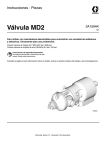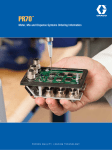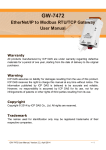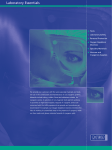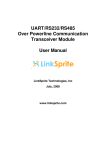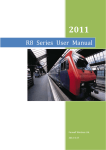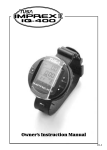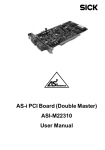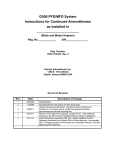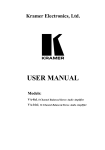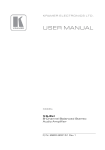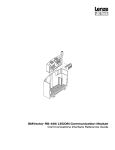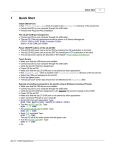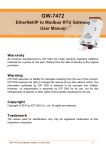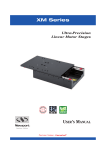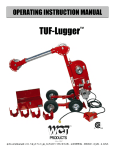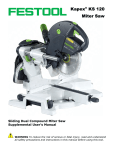Download Phase IV Report - University of Delaware
Transcript
Phase IV Report Dept of ME Senior Design 2007 Team 16 Sponsor: Air Liquide Synopsis The following report is a written statement of progress for Phase IV of the 2007 Senior Design Project. It is intended to provide an overview of the design process that has been implemented up to this point. All graphics are shown full size in the appendix of this document. Experimental Design Having finalized the proof of concept design in Phase III, specific laboratory experiments were performed in order to fine-tune the prototype for final testing. A modular design, which accepted multiple types of rollers, was constructed for the preliminary tests of rollers and resin application. In order to determine the specific type of roller that would be used during the Figure 1 final machine trial, mock trials Table 1 were held using all candidate rollers, mimicking the operation of the proof of concept, as shown in Figures 1 and 2. The logic of the testing process that was followed is shown to the left in Figure 3. Roller parameters are shown in Table 1. A full laboratory procedure is shown in the appendix of this document. Following trials Figure 3 of the rollers, the results of each trial were qualitatively analyzed by examining the process, the end product, and then quantified in a survey. The amount of resin applied to the testing sheets was measured Figure 2 and compared for consistency. The survey rated resin depth, resin coating, air pockets, fiber alignment, wicking, and waste through the opinions of factory engineering personnel. The results of this analysis clearly favored a particular roller model designed for epoxy application, as can be seen in the scores listed in Table 2. Table 2 A thin nap length optimized infiltration in a clean manner without bubbles and fiber abuse. The primary factors that characterized these rollers were amount of resin the nap can hold and the ability of the roller to pressurize the fluid as it is pulled under. The most favorable roller parameters were found in the Wooster R232 4in Epoxy Glide. Not only were the desired properties found, but new properties specific for holding and releasing resin were incorporated in the construction of this roller. The four inch roller was chosen to fulfill the desired resin application band. During the final proof of concept testing, new components for the implementation were found necessary. Although these reiterated previously stated requirements of proper roller contact, further details about implementation were discovered during the final test. It was realized a range of pressure optimizes both resin infiltration and minimal fiber disturbance. For future implementation, the previous design component of a spring load initial application will be reintroduced in the final design. Also, the primary roller needs to be fixed more rigidly, because small deflection alters the initially prescribed bandwidth. Updated Performance Requirements Several performance requirements were updated to ensure the success of the design. The new requirements were established during the preliminary testing of the rollers. Various concerns and corresponding modifications were identified and implemented on the final proof of concept. The updated wants from Figure 4 were then rescored and translated to new target values that are displayed in Table 2 (next page). The two Figure 4 primary metrics concerning technician interaction and void content remained unchanged as the proof of concept evolved. The behavior of the rollers was translated into a metric. Initial tests were performed on rollers that contained bristles and were similar to the paint brushes that are currently used. After testing, the misalignment of fibers, air bubbles, and incomplete infiltration were identified as prominent issues. Variations of smooth rollers were found to produce the best results. A new performance metric added is a quantified flow rate. Testing began by pouring resin from paper cups, and approximating the flow rate then measuring the amount of resin used. It was found that some areas of the loom sheet had too much resin Table 2 Updated Target Values applied, while others did not have enough. This lead to 1 No significant voids some areas having great infiltration and others having very 2 One technician to oversee poor infiltration, thus a very inconsistent method. The 3 No break of roller contact bandwidth varied greatly along the length of the loom, 4 200-230 g/min flow rate which was reflected in the inconsistency of the wicking. 5 Resin at 40 degrees C As a result initial resin application in terms of bandwidth and flow rate was found to be of great importance. It was determined that part of the problem in pouring the resin was due to resin viscosity which was found to be closely tied to the resin temperature during application. A target value of forty degrees Celsius was then established for the resin temperature at application. When the team began testing with resin at this temperature it was found that the application was made much easier. More importantly the viscous effects that had been preventing proper infiltration were now helping in infiltration. Heating the resin to approximately forty degrees Celsius lowered the viscosity and provided not only a more reliable method of pouring the resin but a smoother infiltration by the roller onto the fiber sheet as well. Prototype Details The proof of concept prototype was constructed to demonstrate key design, and technology recommendations for a final design. Specific parameters were optimized in a laboratory environment, and the proof of concept was used to create a test bundle on the production forming machine. The testing configuration for the machine trial can be seen fully set up in Figure 5. The primary roller seen in Figure 6 coats the top of the fiber sheet as it advances, and the secondary roller, shown in Figure 7, coats the bottom of the Figure 5 sheet as the sheet is rolled onto the bushing. The performance of this subsystem was the primary focus of the proof of concept demonstration. Given logistics and budget constraints, a makeshift resin application system was devised to apply resin in a controllable manner. Caulking guns where outfitted with custom cartridges to deliver resin in 50g increments, as shown in Figure 8. The primary roller maintains a fixed position throughout bundle formation. The secondary roller’s height is adjusts as the bundle expands through the use of a simple rotational joint. All components are modified store-bought systems, selected for low cost, disposability, and adaptability. Figure 6 The prototype was outfitted on the production forming machine, and a bundle was produced. One end of the bundle was hand painted by an operator for comparison. The bundle was then cured, machined, and analyzed to determine the Figure 8 Figure 7 performance of the prototype. A close-up of resin infiltrating the bundle is shown in Figure 9. The first indications of superior results were observed during bundle formation. The prototype laid down a very consistent application band and infiltration appeared to be sufficient. Engineering factory personnel were present to supervise the process and were in agreement with the observations made by the team. Figure 9 Performance Evaluation Having formed a bundle on the production forming machine, specific performance characteristics could then be evaluated. Data was gathered and analyzed in a systematic format to validate the performance of the concept technology and legitimatize the choices recommended for final design. The first test that was performed was a hardness test. Forty Figure 10 hardness point measurements were taken, as shown in Figure 10. Ideally the hardness is 65-75 Rockwell. The prototype and the operator-painted end were then compared and the data was plotted in Figure 11. The results of hardness testing favor the performance of the prototype. 80 Hardness Scatter Plot 75 Prototype 65 60 55 Prototype Figure 11 50 Operator Average 70.75 70.05 Median 70.50 70.00 Minimum 66 58 Maximum 76 78 Variance 6.51 25.00 Standard Deviation 2.55 5.00 70 Operator The second test that was performed was microscopy characterization. In order to compare the performance, both ends were examined. The surfaces of the end-caps were analyzed at 100x using an optical magnifier. The inner diameter of the fibers is 90µm and the outer diameter is 160µm. Ideally no voids should exist, and the surface should show uniform distribution as can be seen in Figure 11. Small voids are acceptable, as they do not necessarily constitute a full leak. However, as Figure 12 the size of the void increases, the chance of a gas leak is greatly raised. The end formed by the prototype possessed fewer voids, with less severity than the end painted by the operator despite his experience and skill. Moreover, less interface voids occur between layers on the prototype end, due to the constant applied pressure from the rollers. Typical voids are shown in Figure 13 Figure 14 Figures 13 and 14. The third test that was performed was a gas leak check. The bundle was pressurized to approximately 8 psi and glass beads were placed on the surface of the end caps, as shown Figure 15. Any leaks in the bundle would cause the glass beads to displace, showing a distinct motion on the end-cap. As shown in Figure 16 no leaks were detected on the end formed by the prototype. Given the very positive results of the bundle, the sponsor Figure 15 Figure 16 decided to post-treat the bundle and perform post-production testing. From this testing further void mapping, wicking characterization, and nitrogen recovery rate information will be obtained. This bundle has been post-treated, and the data from all tests will be available to the sponsor in approximately one week. A final leak check also yielded satisfactory results. In order obtain a basic idea of the wicking experienced by the bundle, the resin band was examined for both end-caps. The end formed with the prototype showed a much more consistent band than the Figure 17 Figure 18 operator painted end. Both end-caps are shown to the left, prototype end in Figure 17, operator end in Figure 18. This provides a general idea of the extent of internal wicking. Internal wicking will be determined following post-production testing and bundle dissection. Proof-of-Concept & Solution Differences There are several differences between the proposed proof of concept and the final recommended implementation design. One of the major differences between the two is the use of Liquid Controls systems to provide consistent resin application. This application system will provide a designated constant flow rate. The constant flow rate will add a much greater degree of consistency by applying the optimal amount of resin in an automated manner. Because of this factor, undesirable wicking and resin voids will be decreased. Moreover, less resin will be wasted in the manufacturing process. The temperature of the resin will be continually regulated in the final implementation plan, unlike the proof of concept. While testing the prototype, the resin was heated to approximately 40 degree Celsius before it was loaded to the resin gun and applied. The heating of the resin enabled a better viscosity, but the temperature slowly dropped below the 40 degrees as the resin was applied to the fibers. The implementation plan provides heating of the resin lines until the exact moment of application, through the tube and nozzle tip. This will eliminate any cooling before application, providing a regulated temperature 40 degrees Celsius. This creates a favorable resin viscosity, aiding effective fiber infiltration during production. A permanent setup at the forming machine is incorporated in the final implementation proposal. Instead of employing temporary boom stands next to the machine, a fixed frame will be permanently located, bolted or welded in place in a stable position. This will ensure steady application and eliminate variance in the application area and initial bandwidth. Moreover, the frame will provide a greater degree of rigidity, providing precise positioning of components without concern of shifting during operation. The cost of the final implementation is much greater than the cost of the proof of concept. The working budget of the project is $1500, while the final implemented system is $112,000. The prototype was chosen in accordance with the approved concept budget as a technology demonstrator. Having proven the concept fundamentals, a production solution may be constructed using applicators purchased from Liquid Controls. The system from Liquid Controls will provide more reliability, temperature control, and flow rate control than the application system design to showcase the concept technology of the proof of concept. Design Integration The final proposed design is a synthesis of the roller technology that was validated in the proof of concept and the trusted technology of Liquid Controls resin dispensary systems. The final design addresses the issues discovered in the proof of concept and provides a Figure 19 reliable solution for production. A full operations manual, including design drawings, is located in the appendix of this document. The roller design of the proof of concept proved to be very effective in providing resin infiltration with minimal operator interaction. The design remains largely unchanged Figure 20 for production implementation. Renditions of the final design are shown in Figures 19 and 20. The use of 80/20 aluminum frame to replace the makeshift boom-stand used in the proof of concept will provide greater rigidity and stability. The more frame bases will be bolted to the floor adjacent to the machine. The 80/20 frames provide the adjustability of the stands with the rigidity of a permanent frame. Moreover, the primary applicator preserves the same design, additionally including a vertical translation system to mirror the ability of the secondary roller to adjust on the fly, based on the instantaneous height of the loom-sheet as it advances. The rollers and roller mounts will remain unchanged, as their performance and low cost make them ideal candidates for continuous production implementation. The rollers will be mounted onto a frame instead of a paint Figure 21 roller applicator, which will also fix the resin applicator. The again adds rigidity and consistency in application. The cost of aluminum, fasteners, and small components is conservatively estimated between $1,500-2,000. The resin application of the final design is the recommended system quoted by Wayne Pellicane and Bob Thompson of Graco, Inc. It consists of proven technology that has previously been used by Air Liquide and other manufacturers. The core of the system is two DL-2 gear-driven pump metering systems (Figure 21) with attached hardware. The same model is already in use in the factory floor and has been proven effective and reliable. The metering units draw resin from a common feed source via vacuum. Via a progressive cavity pump (Figure 22), 0.5” heated tubing transports the resin to the point of application. The heating Figure 22 elements on the tubing keep the resin at an adjustable temperature, allowing for constant temperature at the point of application. The feature allows for lowered resin viscosity, aiding infiltration greatly. The application heads of the system are actuated through a Twinmixer system (Figure 23), which is also currently employed in factory operations. The head may be outfitted with various application nozzles, given the desired resin application bandwidth. The Twinmixer assembly will be attached to the same frame as the primary application roller. Figure 23 The entire system is linked to an EnGarde ratio monitor, which automatically checks the content of the resin before the point of application and adjusts the system automatically for optimal performance. All controls for the system are run through a touchFigure 24 screen monitor (Figure 24), allowing a great degree in flexibility of application parameters. Installation and setup of all components will be handled by Liquid Controls. This system will provide a reliable consistent method of applying resin in a controlled manner, which is one half of the key to improving product quality and production optimization. A rendition of the complete system is shown to the left. The total cost of the system is quoted at $112,000. This includes the total cost of the system, plus additional estimated shipping and material costs. An itemized description is provided in the appendix of this document. Although this is a significant sum, the initial cost of the system will be offset if only 2-3 bundles are saved from being reduced to scrap. Coupled with the proven and upgraded roller technology of the proof of concept, this solution will provide the optimal answer to production difficulties, given current process and factory constraints. A rendition of the entire system is shown in Figure 25. Cost analysis The total cost of the project is $400.62. This is well under the maximum developmental budget of $1500. A summary chart is shown in Table 3. A full-sized chart is shown in the appendix. Cost Analysis Table 3 Item name 6060 Aluminum rod 12mm diameter, 1 M length Wooster R232 4" x 1/4" Epoxy Glide roller cover Wooster R232 9" x 1/4" Epoxy Glide roller cover 4" Heavy Duty Cage Frame 2 " PVC Test Cap 131 0800 1.5 " PVC Test Cap 131 060 13" Quart 1/2 Barrel Caul 2" by 2' PVC SCH40 Solid P Tubing , 3/4 MDS Pipe, PV 1/ MDS Ducting, 6" P MDSE Plastic BC MDS Sealant, CL, MDS Gar Fun 8" MDS Valve, 3/4 MDS Tubing, Red T MDSE Paint Pail MDS Boom Stands Cardboard 13" Quart 1/2 Bar 2" PVC Test Cap 1 2" x 2 PVC SCH40 Item Number 1681T27 WOS-R232A-FC WOS-R232AA-FC 186761 23406 23405 41272 256099 91111020025 38561310597 19442245559 98262051618 70798180086 44549050645 19442873011 Not Given 98262506408 N/A N/A 41272 23406 256099 GT Bird Feeder Brush 9" Texture Roller 9" Texture Roller Wheel Detailing Brush 9" Roller frame 235789 62189 41895 236588 40320 Subtotal Total Quantity 1 1 Case of 12 1 Case of 12 2 @ $1.88 each 6 @ $0.52 each 12 @ $0.46 each 1 3 @ $3.17 1 1 2 1 1 1 1 4 1 2 sets @ $101.00 2 @ $4.05 1 8 @ $0.52 1 2 @ 2.94 2 @ $4.48 2 @ 5.47 1 1 Cost $17.63 $14.34 $27.30 $3.76 $3.12 $5.52 $8.87 $9.51 $5.79 $2.19 $6.58 $1.79 $2.49 $1.39 $8.29 $6.36 $6.89 $202.00 $8.11 $8.87 $4.16 $3.17 $5.88 $8.96 $10.94 $2.48 $2.27 $388.66 Shipping Costs $4.25 $7.71 $0.00 $0.00 $0.00 $0.00 $0.00 $0.00 $0.00 $0.00 $0.00 $0.00 $0.00 $0.00 $0.00 $0.00 $0.00 $0.00 $0.00 $0.00 $0.00 $0.00 $0.00 $0.00 $0.00 $0.00 $0.00 $11.96 $400.62 Source MsMaster Carr ePaintStore.com ePaintStore.com Lowe's Lowe's Lowe's Lowe's Lowe's Sear's Hardware Sear's Hardware Sear's Hardware Sear's Hardware Sear's Hardware Sear's Hardware Sear's Hardware Sear's Hardware Sear's Hardware Midwest Percussions UD bookstore Lowe's Lowe's Lowe's Lowe's Lowe's Lowe's Lowe's Lowe's Project Management A Microsoft Project file has been maintained; tracking tasks, responsibility, and progress. A Gantt chart was used to provide an overview of the project timeline at a glance. A full-sized version of the chart is located in the appendix of this document. Correspondingly, labor tracking analysis was also performed. Labor Tracking (08/29/07 - 12/06/07) 18 16 T i m e 14 12 10 8 4 ) ( 6 h 2 0 08/29/07 09/05/07 09/12/07 09/19/07 09/26/07 10/03/07 10/10/07 Figure 26 10/17/07 10/24/07 10/31/07 11/07/07 11/14/07 11/21/07 11/28/07 12/05/07 Date Design & Analysis Labor Fabrication Labor Project Management Labor Test & Evaluation Labor Labor was subdivided into Design & Analysis, Project Management, Fabrication, and Test & Evaluation. An arbitrary rate of $50/hr has been chosen in order to provide an accurate approximation of simulated contract labor. Up to this date, $24,350 in labor is estimated. This is a cost that will not be incurred upon the sponsor. Instead, it is an exercise to impart an additional element of realism to the project. An itemized chart is shown in the appendix of this document. A graph depicting the workload as a function of time is shown in Figure 26. Future Considerations One of the most prevalent considerations for the future use of the production model is mechanical stiffness and shifting. It is recommended that all assembly bolts be coated with bolt sealant, tightened, and examined every time the frame is adjusted. Loose bolts, if ignored for long enough, could allow the roller holder to shift position, adversely affect resin infiltration. The production model has been designed to minimize resin and hardener freezing joints, but potential still exists for unforeseen problems. A sealed joint in the machine could stop the production model from working as it was designed. This is specifically noteworthy on the hinge of the secondary application arm, as this would force the secondary roller to apply too much pressure to the bundle. This build up of pressure could potentially ruin a bundle. Another potential aid for infiltration is an agitator placed on the side of the roller frame. This agitator would create movement in a new direction, which may aid in penetration. This option is recommended only if penetration of the fibers is lacking, because this agitation will adversely affect fasteners and frame positioning during operation. Potential agitators are mechanical, pneumatic, or ultrasonic in nature. At this point, the prototype will be handed-off to the sponsor. The results of testing have been compiled, along with recommendation for full production implementation of the chosen system. The testing performed on the bundle using the proof of concept has yielded very good results. The sponsor has initiated full production testing, from which recovery rate data, leak testing, and further void characterization will be available in the coming weeks, further enhancing analysis of the chosen design technology. Initial post-production testing results are promising. Overall, the proof-of-concept was highly successful and provides a stable theory base for the use of a similar system in future production. Appendix: Liquid Control Equipment Description and Quotation Figure 1 Figure 3 Figure 2 Table 1 Table 2 Appendix: Updated Performance Requirements Images Updated Wants Figure 4 Table 3 Updated Target Values 1 No significant voids 2 1 technician to oversee 3 No break of roller contact 4 200-230 g/min flow rate 5 Resin at 40 degrees C Appendix: Machine Trial Images Figure 5 Figure 9 Appendix: Performance Evaluation Images Figure 10 Figure 12 Figure 13 Figure 14 Figure 15 Figure 16 Figure 17 Figure 18 80 Hardness Scatter Plot 75 Prototype Operator Average 70.75 70.05 Median 70.50 70.00 Minimum 66 58 Maximum 76 78 Variance 6.51 25.00 Standard Deviation 2.55 5.00 70 65 60 55 Prototype 50 Figure 11 Operator Appendix: Liquid Control Images Figure 21 DL-2 Controller Unit Figure 22 Progressive Cavity Pump Resin Line Connection Interface Figure 23 Twinmixer Resin Line Heating Figure 24 Control Interface Appendix: Liquid Control Equipment Description and Quotation Equipment Descriptions: The DL-2 is a stand-alone rotary pump metering system consisting of two gear pumps, a PLC controller with a touch pad operator interface, a monochrome screen with intuitive graphical displays. The mixed material flow rate and volume mix ratio are fully programmable. An Anti gel timer is included to ensure the mixer will be purged periodically. Access to critical process parameters is password protected to prevent tampering by unauthorized personnel . The DL-2 features material recirculation valves and is intended to be used with Liquid Control mix heads that incorporate pneumatic actuation, such as the Twinmixer III series. The mix head must be specified as a separate proposal line item. A footswitch is supplied as standard equipment. The PLC supports a number of optional features, such as the EnGarde ratio monitor, printer, as well as feed system low material level sensors and auto-refill capability. These valuable features can be incorporated at the factory or can be readily upgraded later. The rotary metering pumps are gravity fed directly from 55 gallon drums or reservoirs using optional feed systems supplied by LCC . The precision high and low volume rotary pumps are each driven by AC low -maintenance gear motors. The system ratio accuracy is easily and accurately achieved by using the software driven "5 minute" calibration process. Outlet check valves and fluid pressure gauges are provided for each metering pump. Over-pressure limit switches are provided in each material stream. A pair of low material level sensors are included to provide protection from letting the pumps run in a detrimental dry condition. The control console is easily accessible with top and side hinged doors. The entire DL frame is mounted on an extruded aluminum frame with heavy duty, hard rubber casters for portability. Extruded aluminum feet instead of casters, for DL frame are available if item # 7.24DEC is specified on the proposal. Extended extruded aluminum tank support, frame and console, for use with 10 or 15 gallon tanks. Extended extruded aluminum tank support, frame and console, for use with 10 or 15 gallon tanks. 3.06DEC This upgrade provides one (1) progressive cavity metering pump with maximum flow rate of 33 cc/sec. Wetted components include 300 series stainless steel rotor, cast iron pump internals and plated mild steel fittings. For use with nonlubricious or mineral filled resin systems. 2.33DEC-33MS Extended DL frame length required to accomodate the longer length progressive cavity metering pumps. 2.42 DEC This upgrade provides one (1) ultraprecision 300 series stainless steel gear pump and fittings. 2.34 DEC The pneumatically actuated, Twinmixer III dispense valve for DL, is designed to isolate materials until they reach the disposable Posimixer inlet. The "A" and "B" components enter through individual shut off spool valves and pass through the Twinmixer in separate streams. Upon exiting the Twinmixer nose, the "A" and "B" materials converge in the Posimixer and are thoroughly blended prior to reaching the mixer outlet. The shut off valve rods are operated together for synchronization of the two streams, and when closed, the valve rod spools create a snuff back in the mixer outlet, which controls drip and stringing between shots. The Twinmixer comes complete with 10' teflon lined, stainless steel overbraid hoses. The Twinmixer III is equipped with standard threaded mounting locations to be remotely attached as desired. DL machine telescoping mounting brackets, hand held pistol grips and counter balance mounting may be specified as separate proposal line items. 5.17DEC 10 gallon (37.85L) stainless steel pressure/vacuum tank with 2" bottom outlet, 2" stainless steel ball valve shutoff, two 2" stainless steel barb nipples, 2" dia. chemical hose, two hose clamps and teflon coated lid with three 1/4" (F) npt ports for plug, petcock and relief valve. 3.49A (Continued on the next page) Air Liquide (con’t) 15 gallon (56.78L) pressure/vacuum tank with 2" bottom outlet, 2" mild steel ball valve shutoff, two 2" metal barb nipples, 2" dia. chemical hose, two hose clamps. two 3/4" npt half couplings @ 90° in side wall and one 1/2" npt half coupling in bottom adjacent to bottom outlet. Tank exterior is painted Slate Gray. 3.64 (1) Electric agitator assembly for #3.64 15 gallon pressure/vacuum tank complete with a 1/2 HP AC electric motor, 30:1 gear reducer and sshaft/blade assembly. A 3 position selector switch allows low speed (29 RPM), high speed (58 RPM) or OFF. Requires 115V/1/60 Hz, 10A max. For maximum viscosity of 100,000 cps and maximun material temperature of 275°F. 3.64.EA This 1/4" hose assembly has a PTFE innercore with stainless steel wire overbraid for minimal expansion and moisture permeation. It has a 120" overall length including end fittings which are stainless steel 1/4" JIC female swivel. 61/0037-S120/11 Qty. is per foot. 35 watt (per foot) electric resistance heat tape, foamed silicone insulation and protective covering for a 1/2" Teflon lined, stainless steel braided hose. Heater maximum temperature 275°F. Heat controls are not included. Requires item 3.67.14 (Basic heated hose assembly) to complete the assembly. Qty. is per foot. 35 watt (per foot) electric resistance heat tape, foamed silicone insulation and protective covering for a 1/2" Teflon lined, stainless steel braided hose. Heater maximum temperature 275°F. Heat controls are not included. Requires item 3.67.14 (Basic heated hose assembly) to complete the assembly. 3.67.14A Provide two (2) prox type electric feed system level sensors in a DL drum feed kit assembly or reservoir wall. Depending on configuration options, sensors provide a signal to the DL's PLC, that either alerts the operator to a low material level condition, or signals an auto refill transfer pump to stop and start. Level sensors are mounted in sealed teflon fittings and provide positive level recognition in real time. Sensors never touch the resins, thus can not become contaminated 4.51DL Provide the required electric / pneumatic actuator and controls to stop and start one (1) transfer pump, used to automatically refill one (1) DL reservoir. Requires prox material level sensors and transfer pumps which are priced separately. 4.56 DL NEMA 12 enclosure fitted with digital temperature controller, load circuit breakers, service disconnect circuit breaker, control power selector switch (On/Off) and pilot light for three heat loads. Service requirement-208-240/1/60. Maximum wattage-5000 watts. 3.67.21 4000 watt electric resistance heat blanket and foamed silicone insulation blanket for a 15 gallon capacity feed tank. Heater maximum temperature 275°F. Feed tank and heat controls are not included. 3.67.06 (Continued on the next page) Air Liquide (con’t) Quotation Summary Product Code DL-2 3.06DEC Qty 2 1 2.33DEC-33MS Steel 2.42 DEC 2.34 DEC Upgrade 5.17DEC hoses 3.49A 3.64 3.64.EA 2 Description DL-2 Rotary pump metering system DL Extruded aluminum support for 10 or 15 gallon tanks Progressive Cavity Pump Upgrade-33cc/sec,Mild 2 2 DL Extended Frame Length for PC Pumps Ultraprecision SS300 Gear Pump & Fitting 2 Twinmixer III Dispense Valve for DL with 15' 1 1 1 10 gallon stainless steel pressure/vacuum tank 15 gallon mild steel pressure/vacuum tank (1) Electric agitator ass'y for 15 gallon press/vac tank 61/0037-S120/11 2 1/4" x 120" PTFE/SS Hose Assembly, SS Fittings 3.67.14A 10 1/2" heated hose length, heated by the foot. 3.67.14A 10 1/2" heated hose length, heated by the foot. 4.51DL 1 (2) feed system level prox sensors for DL 4.56 DL 2 Automatic refill actuator for one (1) DL reservoir 3.67.21 1 Three load heater controller and enclosure, 208-240/1/60 3.67.06 1 15 gallon tank heater and insulation Item of 1 Wet Test at North Canton, OH Item of 1 On site start-up services PRICE, F.O.B. NORTH CANTON, OHIO (Freight is additional)……………………………….$109,666.00 Appendix: Implementation Renditions Figure 25 Figure 19 Figure 20 Appendix: Optimistic, Expected, & Pessimistic Resource Loading Appendix: November Scheduling Calendar Appendix: November Scheduling Calendar Appendix: Gantt Chart Appendix: Materials Cost Tracking Cost Analysis Table 4 Item name 6060 Aluminum rod 12mm diameter, 1 M length Wooster R232 4" x 1/4" Epoxy Glide roller cover Wooster R232 9" x 1/4" Epoxy Glide roller cover 4" Heavy Duty Cage Frame 2 " PVC Test Cap 131 0800 1.5 " PVC Test Cap 131 060 13" Quart 1/2 Barrel Caul 2" by 2' PVC SCH40 Solid P Tubing , 3/4 MDS Pipe, PV 1/ MDS Ducting, 6" P MDSE Plastic BC MDS Sealant, CL, MDS Gar Fun 8" MDS Valve, 3/4 MDS Tubing, Red T MDSE Paint Pail MDS Boom Stands Cardboard 13" Quart 1/2 Bar 2" PVC Test Cap 1 2" x 2 PVC SCH40 Item Number 1681T27 WOS-R232A-FC WOS-R232AA-FC 186761 23406 23405 41272 256099 91111020025 38561310597 19442245559 98262051618 70798180086 44549050645 19442873011 Not Given 98262506408 N/A N/A 41272 23406 256099 GT Bird Feeder Brush 9" Texture Roller 9" Texture Roller Wheel Detailing Brush 9" Roller frame 235789 62189 41895 236588 40320 Subtotal Total Quantity 1 1 Case of 12 1 Case of 12 2 @ $1.88 each 6 @ $0.52 each 12 @ $0.46 each 1 3 @ $3.17 1 1 2 1 1 1 1 4 1 2 sets @ $101.00 2 @ $4.05 1 8 @ $0.52 1 2 @ 2.94 2 @ $4.48 2 @ 5.47 1 1 Cost $17.63 $14.34 $27.30 $3.76 $3.12 $5.52 $8.87 $9.51 $5.79 $2.19 $6.58 $1.79 $2.49 $1.39 $8.29 $6.36 $6.89 $202.00 $8.11 $8.87 $4.16 $3.17 $5.88 $8.96 $10.94 $2.48 $2.27 $388.66 Shipping Costs $4.25 $7.71 $0.00 $0.00 $0.00 $0.00 $0.00 $0.00 $0.00 $0.00 $0.00 $0.00 $0.00 $0.00 $0.00 $0.00 $0.00 $0.00 $0.00 $0.00 $0.00 $0.00 $0.00 $0.00 $0.00 $0.00 $0.00 $11.96 $400.62 Source MsMaster Carr ePaintStore.com ePaintStore.com Lowe's Lowe's Lowe's Lowe's Lowe's Sear's Hardware Sear's Hardware Sear's Hardware Sear's Hardware Sear's Hardware Sear's Hardware Sear's Hardware Sear's Hardware Sear's Hardware Midwest Percussions UD bookstore Lowe's Lowe's Lowe's Lowe's Lowe's Lowe's Lowe's Lowe's Appendix: Labor Tracking Sheet Date 08/29/07 09/03/07 09/04/07 09/05/07 09/14/07 09/16/07 09/17/07 09/18/07 09/20/07 09/25/07 09/27/07 10/08/07 10/10/07 10/14/07 10/16/07 10/22/07 10/26/07 10/28/07 10/29/07 11/04/07 11/06/07 11/08/07 11/09/07 11/11/07 11/12/07 11/14/07 11/15/07 11/19/07 11/25/07 11/26/07 11/27/07 11/28/07 11/29/07 11/30/07 12/04/07 12/05/07 12/06/07 12/07/07 Design & Analysis Labor 9 7 4 10 4 4 4 9 6 8 8 12 12 14 12 12 3 10 4 2 4 4 5 3 4 5 4 15 4 1 2 2 2 3 2 2 15 18 Project Management Labor 4 6 6 8 8 6 6 10 10 6 4 1 1 3 1 0 0 6 2 4 3 3 1 4 1 1 2 2 2 1 1 0 1 0 5 1 1 1 Per hr Cost Running Total $50 $24,350 Fabrication Labor 0 0 0 0 0 0 0 0 0 0 0 0 0 0 0 4 0 0 0 0 4 3 4 2 3 4 3 1 2 3 0 4 1 1 0 0 0 0 Test & Evaluation Labor 0 0 0 0 0 0 0 0 0 0 0 0 0 0 0 0 6 0 0 4 6 3 6 3 4 3 3 2 2 5 2 2 3 12 2 6 3 0 Total Hours 13 13 10 18 12 10 10 19 16 14 12 13 13 17 13 16 9 16 6 10 17 13 16 12 12 13 12 20 10 10 5 8 7 16 9 9 19 19 Total Cost $650 $650 $500 $900 $600 $500 $500 $950 $800 $700 $600 $650 $650 $850 $650 $800 $450 $800 $300 $500 $850 $650 $800 $600 $600 $650 $600 $1,000 $500 $500 $250 $400 $350 $800 $450 $450 $950 $950 Appendix: Labor Tracking Loading Chart Labor Tracking (08/29/07 - 12/06/07) 18 16 T i m e 14 12 10 8 4 ) ( 6 h 2 0 08/29/07 09/05/07 09/12/07 09/19/07 09/26/07 10/03/07 10/10/07 10/17/07 10/24/07 Figure 26 10/31/07 11/07/07 11/14/07 Date Design & Analysis Labor Fabrication Labor Project Management Labor Test & Evaluation Labor 11/21/07 11/28/07 12/05/07 Appendix: Roller Selection Lab Objective: Determine the physical attributes of different store bought cylindrical brushes associated with the specific epoxy and fiber infiltration. Theory: The brush filler (bristles) material needs to be optimized for stiffness and also minimized for abrasiveness. Because the fluid flow is too complicated to model or fully understand, the aim of the experiment is to mimic the current human application by way of an automated cylindrical brush infiltration. Several store bought brushes will be used to create an array of data for optimal brush attributes. Nap size, relative stiffness, individual bristle diameter, and bristle density/arrangement will be initially measured quantitatively and qualitatively. As a side note, manual shaking of the rollers’ support stand will give insight as to whether more investigation on mechanical vibrations as an aid for infiltrating is worthwhile. Materials: store bought cylindrical brushes – experimental variables epoxy resin – resin containing catalyst will be used because of availability. Although the catalyst will require additional safety measures: safety reasons, proper ventilation will be needed as along with proper safety garments including gloves, arms sleeves, and safety goggles. pre-fabricated fiber loom – fibers will be wrapped around cardboard covered in Reemay. boom stand – help locate the brushes in the proper location for infiltration Procedure: 1. 2. 3. 4. Place the loomed sheet of fibers under the ventilation hood. Attach the brush of interest onto the boom stand. Adjust the boom stand so the brush is at the desired location relative to the fibers. Carefully poor epoxy at one end of the loom sheet as another person slowly advances the sheet through the roller setup. (Note: The pouring of epoxy and pulling of sheet don’t need to be exact compared to current process for this initial test, but these actions should be comparably for a proper test.) 5. A trained eye will be given a survey to extract his/her qualitative opinion on attributes agreed on that create a proper infiltration. (From this, it is determined which brushes are potentially able to reconstruct current infiltration with finer testing adjustments. 6. Repeat process for each brush. Analysis: From our tests we should be able to discern the type of cylindrical brush we want to spend more time on investigating its capability to proper infiltrate the epoxy through out the loom of fibers Qualitative Survey Answer with scores from 1 to 5, 5 being the best. ____ Did the resin reach a satisfactory depth into the fibers? (depth is considered as looking into the sheet from above) ____ Were the fibers misaligned or handled poorly during the infiltration process? ____ Was the wicking very inconsistent or undesirable in anyway? ____ Are the fibers fully coated around its surface? ____ Is the process much messier compared to the current production process? ____ Is there a solid layer of resin encompassing the fibers, i.e. no large air pockets? 11/16: First Test Day 1-Smooth: Surprisingly, infiltrated decently. Roller was not completely smooth. Pressure was not much. 2-Yellow mesh: Coating looked better, mess was due mainly to viscosity 3-Birdfeeder: New epoxy used during testing 4-Yellow mesh: Used to determine wet testing. Performed a little bit worse in terms of wicking, but besides this was about the same. 11/19: Second Test Day 1-Bunny 1: Resin was heated which resulted in a significant drop in viscosity. 2-Bunny 2: Heated slightly above 40 degrees c, assuming there would be a drop in temperature during actual application. Resin band was about the same, same ratings. 3-Gray 1: Sheet is very thick and the roller was still able to infiltrate well 4-Gray2: Roller performed as well wet. This tells us that the roller does not need to be pre-wetted before use. More resin could have been used, this is the only reason that the score for question four was lower than the first test of the gray roller. 5-Power spiral: Lots of resin was left on the surface of the fibers, inadequate pressure from the roller. 6-Gray3: There was quite a bit of excess resin being pushed of the side. We learned that the infiltration was maximized when the application area was within an inch and a half of the edge, this also prevented the resin from wicking in too deeply. By pausing between tests of this roller we learned that the roller won’t respond differently if the a fiber breaks and the worker is forced to stop the looming machine. 7-Control: Infiltrated top, just sitting there though. Active infiltration is found to be critical Appendix: Resin Application Lab Resin Application Lab Objective: To determine the amount of resin applied to the fibers during the formation of a 6 inch bundle. The team will also analyze inconsistencies in resin application amount between trials and technicians. Theory: A main concern in the application of resin is the inconsistency that is present. There are discrepancies in the amount of resin applied on each side of the bundle due to different technicians and techniques. There is also a variation in the resin application amount throughout the process due to a lack of a predefined application method. Materials: Forming machine setup multiple resin cups scale Epoxy resin Procedure: 1. Once the forming machine is set up obtain 2 cups of resin from the dispensing systems 2. Weigh the cups of resin on the scale and return them to the technicians on each side of the machine 3. Record the weight of each cup 4. Once the technicians are finished with the cups of resin, weigh them again on the scale and record their values 5. Repeat these steps weighing the cups of resin before and after use until process is finished with a completed bundle Data: Bundle # 1 Left Side Cup # 1 2 3 Total Resin used Right Side Cup # 1 2 3 Total Resin used Weight before use 798.6 801.8 - Weight after use 53.7 490.1 Resin amount used 744.9 - Weight before use 805 799.2 - Weight after use 62.3 165.4 - Resin amount used 742.7 633.8 - Bundle # 2 Left Side Cup # 1 2 3 Total Resin used Right Side Cup # 1 2 3 Total Resin used Bundle # 3 Left Side Cup # 1 2 3 Total Resin used Right Side Cup # 1 2 3 Total Resin used Weight before use 802.6 794.8 793.7 Weight after use 49.7 46.6 656.4 Resin amount used 752.9 748.2 137.3 1638.4 Weight before use 792.3 798.9 - Weight after use 47.1 193 - Resin amount used 745.2 605.9 1351.1 Weight before use 798.9 799 N/A Weight after use 44.6 158.4 N/A Resin amount used 754.3 640.6 1394.9 Weight before use 788.7 791.7 N/A Weight after use 43.6 236.6 N/A Resin amount used 745.1 555.1 1300.2 Results: Bundle number 1 was not analyzed due to holes in the data, skewing any obtained results. These holes occurred when the technicians used the resin cups before being initially weighed, or when the technicians discarded the used cups before being weighed. After recording and analyzing the amount of resin applied to bundles 2 and 3, it is confirmed that there is a great deal in variability of resin amount applied to each end of the bundle as well as from bundle to bundle. Bundle 2 used a total of 2989.5 while bundle 3 used a total amount of 2695.1. By calculating the amount of resin used by each technician in each bundle, it is also clear that different techniques yield variable resin application amounts. Looking at bundles 2 and 3, the initial amount of resin provided was very consistent throughout the process. However, the final weights of the cups were continually different measuring anywhere from 94.7 to 287.3 difference in the finished bundles. The technician on the left side consistently used more resin than the technician on the right. Discussion: After performing the lab and analyzing the results, it is clear that a more consistent and standard application method needs to be implemented. There are not only differences in amount of resin used from bundle to bundle, but more importantly, between the left and right side of the bundles themselves. These resin amount discrepancies can be directly related to failure of the product and loss of revenue. Appendix: Wicking Length Lab Wicking Length Lab Objective: To determine the wicking length of the resin once applied to the fibers. Theory: Wicking has been a large problem with the bundle forming process at Air Liquide. When the resin is applied to the fibers, the resin tends to wick further down the length of the fibers until it ceases from curing. This reduces the active filtration area in the bundle this making it less efficient. The more the resin wicks down the fibers, the larger area of bundle needs to be cut off while preparing the bundles. Materials: 1 bobbin of fibers 3 aluminum trays Epoxy resin stopwatch pocket knife notepad ruler permanent marker Procedure: 1. Obtain 3 aluminum trays and using a pocket knife, punch a small hole on each end of each tray 2. Obtain fibers and wind them approximately 10 times around a notepad forming a thin layer 3. Pull the fibers off of the notepad and arrange in the aluminum trays, pressing the ends of each fiber bundle through the small holes 4. On each tray, using the permanent marker, mark off a designated length of fiber where the resin will be applied and record 5. Apply the resin with a paintbrush in on each marked off section of fibers and start the stopwatch. 6. Wait for resin to cure and observe wicking outside application area 7. Record length of wicking from each section and the time elapsed Data: Tray 1 2 3 Application Area 1” 2” 3” Wicking length negligible negligible < 1 inch Time elapsed: 1 hour Results: After the resin was cured and 1 hour had elapsed. The fibers were analyzed for wicking. Contrary to the team’s hypothesis, the wicking was very minimal in all 3 trays measuring less than 1 inch in all cases. After talking to the technicians and Air Liquide employees it was understood that the wicking does not necessarily come from the resin application itself, but the pressure the fibers are faced with. This occurs when the fiber weave is rolled up and squeezed in the nip. Discussion: After performing the lab and analyzing the fibers it was determined that wicking is a problem that is very hard to avoid. The majority of the wicking comes from the bundle rolling and not the application itself, fixing the problem and making it an uncontrollable. Therefore, the team will move on focusing it’s efforts on other areas of concern. Appendix: Hardness Testing Lab End-Cap Hardness Lab Objective: To determine the hardness of the end-caps of the cured bundle, formed using the prototype. Theory: A hardness test is often performed to determine the density and saturation of the epoxy resin. Areas with good resin saturation are harder vs. areas with voids and only fiber. A hardness test was done on each end of the bundle to compare the roller side with the technician painted side of the bundle and to assess the quality of the bundle. Procedure: 1. Divide the bundle into quadrants with 5 testing points in each quadrant working in a line from the inside outward. 2. Measure the hardness of the surface at all testing points Results: Prototype Operator 67 70 74 66 72 71 67 68 70 74 71 73 70 70 71 72 70 73 70 76 75 66 78 70 70 76 70 72 69 77 73 71 60 58 66 68 70 71 72 69 Measurements in Rockwell Scale The optimal hardness range for the bundles is between 65 and 75. Both ends of the bundles were tested and it was found that a majority of the scores fell into this range. The table is divided into values in groups of 5, to show the variance of the scores with respect to location on the bundle end. It was found that the lower scores and softer areas were often present in the middle to mid bundle regions. This may be because the team took a few turns to get the technique down and thus missed a few small areas at the very beginning of the bundle forming process. 80 Hardness Scatter Plot 75 Prototype 70 65 60 55 Prototype 50 Operator Average 70.75 70.05 Median 70.50 70.00 Minimum 66 58 Maximum 76 78 Variance 6.51 25.00 Standard Deviation 2.55 5.00 Operator User Manual For the Resin Application System: Production Model Written by University of Delaware Students: Kevin Malik Pete John Laura Shultz Adam Willoughby-Knox December 7, 2007 Table of Contents • Before you get started!............................................................................................ pg3 o Terminology o Important notes • Assembly & Installation……………………………………………………………………………………… pg4 o Primary application system o Secondary application system • Recommended Use……………………………………………………………………………………………. pg5 o Attaching & removing rollers o Starting a new bundle o Stopping the process o Adjusting the secondary roller holder position o Finishing a bundle • Trouble Shooting, Possible Issues - Symptoms and Solutions…………………………….. pg7 o Rotating roller o Bending arm o Clogged dispenser tip o Secondary application arm interference Drawing Package………………………………………………………………………………………………… pg8 • Before you get started! Terminology Browsing through this section before reading the rest of the user manual will vastly help in understanding the mechanics of the production model. While reading through the user manual you will notice direct references made back to these terms will be marked in bold, upon their first use. 1. Production Model (whole system shown to the left) 2. Primary Applicator / Application System (assembly) 3. Secondary Applicator / Application System (assembly) 6 2 4. Base 5. Pillar 6. Primary Arm 7. Roller Holder 8. Roller 9. Clamp 10. Pull-Bar 11. Clamp Arm 12. Bushing 13. Roller Housing 3 7 13 10 5 9 8 11 4 12 If there is any confusion over the parts please reference the drawing package included at the end of the manual. Important Notes 1. Please read through all of the directions before proceeding! 2. Please keep personal safety and the safety of others in mind at all times. Assembly & Installation The production model is comprised of two applicator systems. The primary application system makes contact with the flat sheet that is produced by the looming machine and is secured to the ground. The secondary application system makes contact on the rolled bundle and naturally changes position as the bundle’s radius grows. The secondary application system is secured to the pull-bar of the machine. The first task in setting up the production model is to correctly determine the primary application area. The roller itself must make contact after the nozzle from the Resin Application System (RAS), and should barely hang off the edge of the sheet of fibers. Be careful not to place the roller so close that it might interfere with the bundle as it is being wound. The suggested placement of this roller is approximately four inches from the plastic splash guard attached to the looming machine. With the application area selected, one may now choose the placement for the base of the applicator system to the ground by moving perpendicularly away from the application area, and directly downward. This placement is crucial as the production model is not fully adjustable in this direction. Make sure that this footprint does not interfere with any existing machinery. The base may now be attached to the ground via bolting. With the base in place, the pillar may be attached via bolting. Attaching the primary arm to this will help in correctly positioning the other side’s base. With the space for the second base selected, bolt it into the ground and attach the second pillar. Before securing the arm in place with the bolts, make sure that the arm hangs over the previously selected application area. Attach the two roller holders to the primary arm, to help you position the arm at a height on the pillar that allows for the spring mechanism in the roller holders to be depressed. Once the arm is bolted in place the primary applicator system is fully installed! Congratulations, you are more than half way there. Similar to the primary applicator installation, begin the installation of the secondary application system by orienting the roller at its contact point. The secondary roller makes contact on the bushing that the bundle builds up on. Again, the roller should just barely hang off of the edge of the bundle. The clamp on the secondary applicator system should be mounted in-line with the roller, on the pull-bar. Make sure that the clamp arm is near horizontal to the ground. Next attach the roller holder to the second arm so that the roller makes contact on the far side of the bushing. Recommended Use Attaching and removing rollers is a simple matter of loosening the set screws attaching the roller holder to the roller housing of the application system (primary or secondary). When this is done, the entire roller holder may be removed. The epoxy roller may then be slid on or off. When removing the roller, proceed with caution, the roller will be filled with unused epoxy. Starting a new bundle will call for the attention of operator. The first step the operator is responsible for is replacing the two nozzles of the Resin Application System. The operator is then expected to setup the remay, position the application systems, and most importantly apply resin to the remay that is attached directly to the bushing. It is vital that the remay adhere properly to the tube. Once the fibers reach the area where the resin is applied, the operator is expected to activate the resin dispensary system. Following this, the operator is needed to make sure that the ends of fibers (from starting the wrapping process) protrude from the side of the bundle. Stopping the process would still be controlled through a “kill switch” which could be relocated to a more convenient station designed for a single operator. This switch is electronically tied to both the Resin Application System and the feed for the looming machine. This switch is to be used in case of emergencies, or if a fiber breaks and needs to be rewound by the operator. Adjusting the secondary roller holder position may be necessary for the larger diameter bundles. On the six inch bundle created during testing, adjusting the secondary roller holder was not necessary. This is a preventative measure that keeps the roller from advancing past the top of the bundle. A roller that is allowed to advance too far could interfere with a secondary resin application system (if there is one) or could tip and fall backwards away from the machine. Falling away from the machine in this manner could possible injure a worker, and would most certainly create an inconsistency in the bundle. To overcome this issue it is recommended that one replace the secondary system half way through bundle creation with another secondary system that has a longer clamp arm. Finishing a bundle again calls for the use of an operator. After the bundle has reached the expected diameter, the fibers need to be cut by the operator. The Resin Application System may be turned off after the end of the fiber sheet has passed by the application point. As remay is wrapped around the bundle, excess resin will build up in front of the rollers. This resin must be controlled by the operator so that it is present, but does not overflow to the inner side of the roller. When the operator is prepared to wrap both sides in plastic he may remove the secondary application systems, or simply rotate them off of the bundle. The operator is then expected to wrap both sides of the bundle in plastic wrap, heat both sides to shrink the wrap to the bundle, and label the bundle. Trouble Shooting, Possible Issues - Symptoms and Solutions A rotating roller is characterized by a roller holder that wobbles and thus adversely affects the penetration. This problem is typical of a roller holder that has been improperly secured to the arm of the system. This issue can be remedied by having the operator ensure that all bolts are securely fastened after attaching a new roller. If the problem is not noticed it is possible for the roller holder to become loose enough to come free of the arm and become caught in a pinch zone between bundle and the looming machine. This would most assuredly result in the loss of a bundle, and possibly damage the machine as well. In the primary application it is possible that the arm begins to noticeably lean away from the position it was originally placed in. This is noticeable because the roller holder will drift closer to the bundle as it is being rolled. If the arm can visually be seen experiencing a bending moment, there is too much downward pressure being applied by the roller. Excess pressure can be created by mounting the arm too low on the pillars, or if the spring mechanism in a roller holder is stuck in a depressed position. This issue should be caught by the operator after a quick visual inspection. To solve this issue one merely needs to re-secure the arm to the pillar, or replace the roller holder. DO NOT merely jog the spring free from its depressed position; it will most likely get stuck again later! If a dispenser nozzle of the application system is clogged, or stops dispensing the proper amount of resin the control system of the Resin Application System will alert the operator, and can be set to automatically stop the looming machine. The nozzles snap on and off, along with the mixing screws. This error is most likely caused by operator failing to replace the nozzle/mixing screw with a new bundle. If this error persists, confirm that enough resin and hardeners are in the source buckets. If no solution can be found contact Liquid Controls for advice, as the issue is most likely related to the Resin Application System. If the secondary application arms take up the room on the pull bar that is needed for plastic wrapping or removing the bundle, the arms may either be folded back, or the assembly can easily be removed. Extending the arm away from the looming machine may create safety hazards, as the operator would have to be cognizant of the arms while moving the bundle to the drying station. Drawing Package

































































